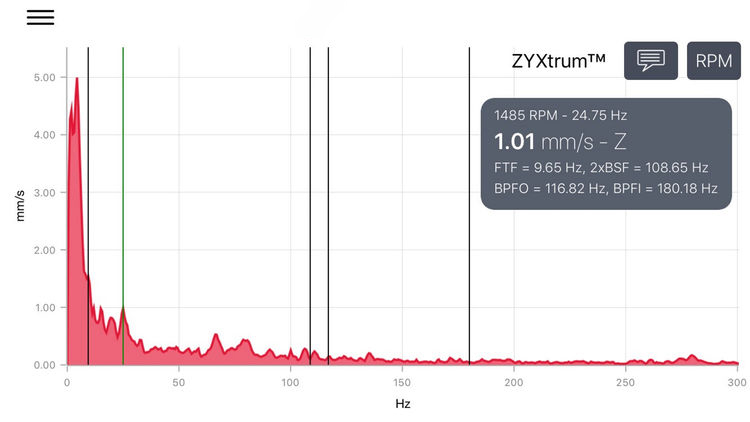Frequency is as simple as the name implies, it is the number of times an event occurs in a set amount of time. In vibration analysis, we reference frequency to either cycles per second (Hz) or cycles per minute (CPM).
Calculating Frequency & Cycles Per Minute (CPM)
The frequency can be expressed mathematically as 1/T, where T is the amount of time it takes to complete one cycle. If the repeating event occurs every .03 seconds, then we can use the formula:
1/0.03 = 33.333333 Hz
This means that the event happens 33.3333 times every second. If you are like me and prefer to use CPM, then you would simply multiply by 60 to get the result as cycles per minute. The formula looks like this:
33.33333 * 60 = 2000 CPM
Again, the frequency is 2000 CPM, so that means that the event occurs 2000 times every minute!
Understanding Frequency Peaks
When performing vibration analysis on a piece of equipment, we are always looking at repeatable events in the form of frequency. This is to tie the suspect peaks in the FFT spectrum to a component in the system that is vibrating at that frequency. In the example above, maybe we have a 3600 RPM motor on a VFD operating at a little better than half the rated operating speed with maybe a slight unbalance.
We often encounter frequencies related to gearsets. For instance, if a gear has 20 teeth, it means that for every rotation of the shaft, there are 20 instances of contact between the teeth. This results in vibrations at a frequency of 20 times the RPM, which is the frequency at which the teeth contact each other.
Another example would be in a pump with 5 vanes. As each pump vane passes by the volute you will get a vibration that will be at the frequency of 5 x RPM.
You will have all the information you need when you know the different frequencies in a system by collecting vibration data, reviewing the FFT spectrum and the force-generating components of the system itself. With this information, you will be able to determine any mechanical issues that are present. Then you can address those issues before the machine experiences catastrophic failure. This allows us to very accurately confirm different failure modes while the machine is running.
Frequency and Period Calculation
There is more to the story though. If you know the frequency you can quickly determine the amount of time it takes to complete one cycle also known as “period.”
The formula for this is 1/F where F is the frequency in question. Using the same values as we did in our previous calculation this would be expressed as:
2000/60 = 33.33333 Hz
(the period is most often displayed in seconds not minutes)
1/33.3333 = .03 seconds
As you can see, it just brought it back to the number we were originally working with, an event happening every .03 seconds. Knowing this math will especially come in handy when you are analyzing the raw time waveform data. It can also be useful when analyzing slow-speed equipment, as the FFT becomes slightly less useful, and we tend to view a long-time waveform looking for repeating events.



